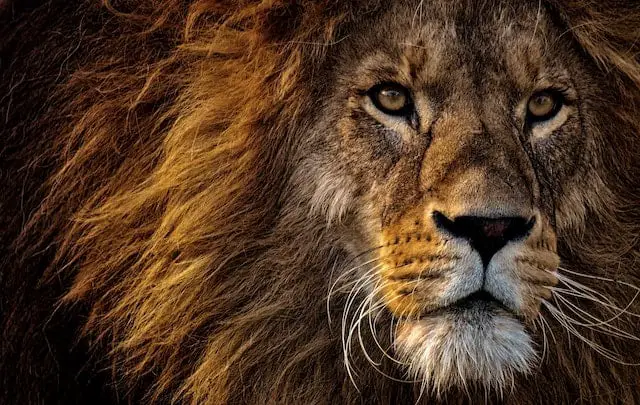Who is Aslan in the Chronicles of Narnia?
Aslan is the central figure in all seven Narnia books. (Apparently, Aslan is Turkish for lion.) All the stories revolve around him.
He is the King over all, but not tied down to a location— he comes and goes at his own desire. He also holds the ultimate power and understands the deepest magic. He is able to defeat evil by sacrificing his own life, the reverse of the common belief about the most powerful.
Aslan the talking lion is a deeply layered, complex character—fierce and playful, powerful and gentle.
No wonder Narnia is so compelling, with Aslan ruling there.
Who is Aslan in The Lion, the Witch and the Wardrobe?
Aslan is first introduced by reputation only, when Mr. Beaver is talking to the Pevensie children.
“Aslan is a lion- the Lion, the great Lion.” “Ooh” said Susan. “I’d thought he was a man. Is he-quite safe? I shall feel rather nervous about meeting a lion”…”Safe?” said Mr Beaver …”Who said anything about safe? ‘Course he isn’t safe. But he’s good. He’s the King, I tell you.”
As the story progresses, it’s Aslan who defeats the White Witch and ends her reign by the willing sacrifice of his own life.

Who is Aslan in the real human world?
At the end of The Voyage of the Dawn Treader, when Lucy is returning to England and is told that she won’t be coming back to Narnia she is distraught.
“It isn’t Narnia, you know,” sobbed Lucy. “It’s you. We shan’t meet you there. And how can we live, never meeting you?”
“But you shall meet me, dear one,” said Aslan.
“Are -are you there too, Sir?” said Edmund.
“I am,” said Aslan. “But there I have another name. You must learn to know me by that name. This was the very reason why you were brought to Narnia, that by knowing me here for a little, you may know me better there.”
This interchange provoked readers to ask who Aslan is in our world?
As to Aslan’s other name, well I want you to guess. Has there never been anyone in this world who (1.) Arrived at the same time as Father Christmas. (2.) Said he was the son of the great Emperor. (3.) gave himself up for someone else’s fault to be jeered at and killed by wicked people. (4.) Came to life again. (5.) Is sometimes spoken of as a Lamb…. Don’t you really know His name in this world. Think it over and let me know your answer!
Who is Aslan supposed to represent? Is Aslan God or Jesus?
This can’t be answered without a basic understanding of the trinity. The Christian doctrine of the trinity is that God exists in three persons— God the Father, God the Son (Jesus Christ) and God the Holy Spirit. In a mystery that is hard for the finite mind to grasp, these three persons exist together in one— God.
Those familiar with Christian theology can easily see the parallels Lewis draws in The Lion, the Witch and Wardrobe between Aslan and Jesus Christ.
In The Magician’s Nephew, we see Aslan as Creator of all things. In The Horse and his Boy we see him as Comforter. The Aslan character is more complex than just one person of the trinity. He embodies all three.
So, yes, he represents Jesus Christ and yes, he represents God.
The character of Aslan fleshes out the biblical imagery as the Lion of Judah.
Aslan as Redeemer
The Lion, the Witch and the Wardrobe was the first Narnia book that Lewis wrote. In it, Aslan willingly laid down his life. He was slaughtered by the enemy as a ransom for the traitor, Edmund Pevensie After his death, he returned to life. The willing sacrifice of his life parallels the death and resurrection of Jesus Christ as a ransom for every sinner.
Aslan as Creator
The Magician’s Nephew is the book that tells the story of the creation of Narnia and surrounding countries in Lewis’s alternate reality. The children from England arrived in Narnia in time to witness the death of one world and the birth of a new one. They watched Aslan as he sang the song that brought it into being.
Aslan as the Comforter
There’s not much depiction in the books of Aslan as God the Holy Spirit.
But one scene in The Horse and his Boy brings to mind God the Holy Spirit as the Comforter.
It’s when Shasta is frightened spending the night alone among the tombs. A stray cat comes to keep him company and comfort him through the night.
At the end of the book, when Aslan explains to Shasta the many times he intervened in Shasta’s life, he includes the incident of the comforting cat.
“I was the lion.” And as Shasta gasped with open mouth and said nothing the Voice continued. “I was the lion who forced you to join with Avaris. I was the cat who comforted you among the houses of the dead. I was the lion who drove the jackals from you while you slept. I was the lion who gave the Horses new strength of fear for the last mile so that you should reach King Lune in time. And I was the lion you do not remember who pushed the boat in which you lay, a child near death, so that it came to shore where a man sat, wakeful at midnight, to receive you.”
Every metaphor and allegory breaks down at some point, but Lewis does a masterful job of representing the many facets of God in the character of Aslan.
I think C.S. Lewis was successful in his attempt to “smuggle theology behind enemy lines”.



1 Comment on Who is Aslan in the Real World?